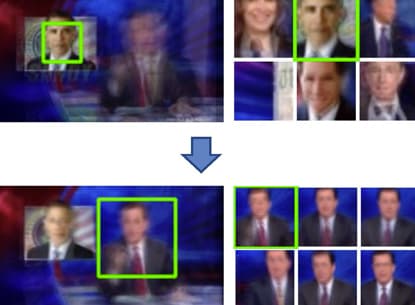UC Berkeley Researchers Create Tool To Average Images
The amount of visual data is growing and it is growing fast. How fast? See for yourself:
AverageExplorer makes it easier to analyse 'chains of related images' such as that of brides and grooms at weddings or that of a graduation ceremony. Specific features in images could be given more 'weight' by the user to create subcategories and make sorting easier. The researchers said that potential applications include online shopping, media analysis, sports analysis, etc.

The tool lets users focus on images in which President Obama appears over Stephen Colbert’s shoulder. Users can also observe Colbert’s typical body posture among those results.
Yong Jae Lee further stated that the efficiency of Computer Vision systems in deducing key features from images could be improved using this technique. For example, a face recognition system needs to be trained using lot of data which requires a considerable manual effort. Instead, if the average image is annotated for features (such as eyes, nose and mouth), the effect could propagate down the collection to each individual image.
It is worth to note here that an artist, Jason Salavon has created average images from hundreds of photos of kids with Santa, newlyweds or baseball players to illustrate this concept of 'image averaging'. Check out his amalgamation work on Chicago city's photos taken from the city's typical tourist points #-Link-Snipped-#. But unlike Salavon, the scientists automated the process of aligning and sorting the images.
On a parting note, if we could create an average of a number of averages, we could have an 'image within an image' or an "Inception"-styled image. We could call it 'Im'ception.
Nevertheless, share your views in the comments. Also feel free to bash the author if you thought the 'Im'ception joke was a bad one.
Source: #-Link-Snipped-#
- Facebook users upload 350 million new photos each day (<a href="https://www.businessinsider.in/Facebook-Users-Are-Uploading-350-Million-New-Photos-Each-Day/articleshow/22709734.cms" target="_blank" rel="nofollow noopener noreferrer">Facebook Users Are Uploading 350 Million New Photos Each Day | Business Insider India</a>r)
- Snapchat sees even more, about 400 million photos each day (<a href="https://techcrunch.com/2013/11/19/snapchat-reportedly-sees-more-daily-photos-than-facebook/" target="_blank" rel="nofollow noopener noreferrer">Snapchat Sees More Daily Photos Than Facebook • TechCrunch</a>)
- 27,800 photos are uploaded to Instagram every minute (#-Link-Snipped-#)
- Google Maps alone has over 20 petabytes (about 20.5k TB) data (#-Link-Snipped-#)
- Jan Koum of WhatsApp claimed over 400 million photos per day (#-Link-Snipped-#)
AverageExplorer makes it easier to analyse 'chains of related images' such as that of brides and grooms at weddings or that of a graduation ceremony. Specific features in images could be given more 'weight' by the user to create subcategories and make sorting easier. The researchers said that potential applications include online shopping, media analysis, sports analysis, etc.

The tool lets users focus on images in which President Obama appears over Stephen Colbert’s shoulder. Users can also observe Colbert’s typical body posture among those results.
It is worth to note here that an artist, Jason Salavon has created average images from hundreds of photos of kids with Santa, newlyweds or baseball players to illustrate this concept of 'image averaging'. Check out his amalgamation work on Chicago city's photos taken from the city's typical tourist points #-Link-Snipped-#. But unlike Salavon, the scientists automated the process of aligning and sorting the images.
On a parting note, if we could create an average of a number of averages, we could have an 'image within an image' or an "Inception"-styled image. We could call it 'Im'ception.
Nevertheless, share your views in the comments. Also feel free to bash the author if you thought the 'Im'ception joke was a bad one.
Source: #-Link-Snipped-#
0
